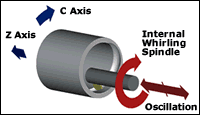A Quick Look Inside Internal Thread Whirling
Using choreographed movement of workpiece and oscillating tool, internal thread whirling can produce difficult helical threads inside parts such as ballscrew nuts.
Share


External thread whirling is an established machining process that can quickly and accurately create intricate helical profiles about small screws and larger shaft parts, such as ballscrews, steering gears and worm gears. A variety of other parts, including ballscrew nuts, require an equally intricate internal thread. Internal helical threads are typically produced through multiple high speed grinding passes. According to Ralph Wehmann, national sales manager for Leistritz Corporation (Allendale, New Jersey), as the length of the thread and/or thread helix angle increase, so does the difficulty in maintaining process stability and thread accuracy when grinding these internal profiles.
The Leistritz Innovation 200 internal whirling machine, new to the United States, offers an alternative to grinding internal helical threads. The dedicated whirling machine has an inverted vertical chucking design, with a special oscillating tooling system that engages the part from below. Inverted vertical chucking enables the machine to serve as its own part loading system for workpieces up to 200 mm in diameter. The multitasking machine offers part probing, hard turning and 12,000-rpm horizontal milling capabilities, in addition to internal whirling, to completely machine a hardened ball nut, for example.
During internal whirling, both the workpiece and single-point whirling tool rotate in the same C-axis direction, though not at the same speed. The workpiece may rotate anywhere between 20 to 50 rpm, while the tool can spin up to 2,285 rpm. During this choreographed rotation, the workpiece is continually fed down the Z axis, while the rotating cutting tool oscillates up and down in the W axis with each tool revolution. This W-axis oscillation allows the tool's cutting insert to remain normal to the thread helix angle to maintain profile accuracy. The amount of oscillation depends on the thread lead.
The whirling tool rotates within a stationary supporting mandrel that extends into the part's internal diameter. A bearing near the end of the mandrel supports the whirling tool near the cutting forces. This helps maintain tool stability when internally whirling parts that have long length-to-diameter ratios. For soft workpiece materials, a carbide cutting tip is used; for steel hardened to 65 Rc, cubic boron nitride (CBN) is used. In either case, machining is performed without coolant, and only one cutting pass is required to produce a finished internal thread.





















